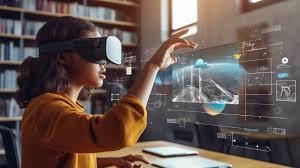Virtual reality (VR) is revolutionizing the educational landscape, providing immersive experiences that enhance learning and engagement. As educators seek innovative methods to capture students’ attention, VR emerges as a powerful tool that allows learners to explore new environments and concepts in a way that traditional teaching methods cannot. This article delves into various aspects of VR in education, highlighting its benefits, applications, and future potential.
The Evolution of Virtual Reality in Education
VR technology has come a long way since its inception. Initially used primarily in gaming and entertainment, its educational applications have gained traction in recent years. With advancements in hardware and software, educational institutions are increasingly adopting VR to create immersive learning experiences. This shift reflects a broader trend towards experiential learning, where students gain knowledge through hands-on engagement rather than passive instruction【51】【52】.
Benefits of Virtual Reality in Education
The use of VR in education offers numerous advantages. One significant benefit is improved retention and understanding of complex subjects. Studies have shown that students who participate in VR-based learning experiences tend to recall information better than those who learn through traditional methods【50】. For instance, immersive VR environments allow students to explore historical sites or scientific concepts in a 3D space, facilitating deeper cognitive associations【51】.
Additionally, VR enhances student engagement. By providing interactive and visually stimulating content, students are more likely to be motivated and actively participate in their learning. This engagement is crucial, especially for learners who may struggle with conventional teaching styles【52】.
Read more about : https://betsays.com/
How Virtual Reality is Used in Education
Virtual Field Trips
One of the most exciting applications of VR in education is virtual field trips. These experiences allow students to visit places they may never physically access. For example, platforms like Google Arts & Culture offer virtual tours of museums, historical sites, and natural wonders. This exposure broadens students’ horizons and enriches their learning experiences【51】【50】.
Interactive Learning Environments
VR creates interactive learning environments that foster collaboration and teamwork. Programs like rumii enable students from different locations to work together in a virtual space, enhancing their learning through shared experiences【51】. This is particularly beneficial for remote learning, where students often feel isolated.
Subject-Specific Applications
VR is especially effective in teaching subjects that benefit from visual and spatial understanding. For example, medical students can practice surgical procedures in a virtual operating room without risk, while biology students can explore the human body in 3D【50】. These practical applications help students grasp difficult concepts by allowing them to visualize and interact with the material actively.
Challenges of Implementing Virtual Reality in Education
Despite its benefits, the integration of VR into educational settings is not without challenges. One significant barrier is the cost of VR equipment and the need for adequate training for educators【50】【52】. Many schools may lack the resources to implement VR programs effectively.
Additionally, there are concerns regarding the potential for cognitive overload in students. If not managed properly, the immersive nature of VR could lead to distractions rather than enhanced learning【51】. Educators need to strike a balance between using VR as a supplement to traditional teaching methods and ensuring it does not overwhelm students.
You may also like this : https://betsays.com/
The Future of Virtual Reality in Education
The future of VR in education looks promising. As technology continues to evolve, we can expect more affordable and accessible VR solutions for classrooms. Furthermore, advancements in software will likely enhance the interactivity and realism of VR experiences, making them even more engaging for students【50】【51】.
Educational institutions are also beginning to recognize the importance of training educators to utilize VR effectively. As teachers become more comfortable with the technology, they can develop innovative lesson plans that incorporate VR, ultimately improving student learning outcomes【52】.
Conclusion
The role of virtual reality in education is transforming how students learn and interact with content. By offering immersive and engaging experiences, VR enhances understanding and retention while fostering collaboration among learners. Just as Tips for Choosing a Washington Car Shipping Service guide individuals in making informed decisions, the implementation of VR requires careful planning and support to ensure it effectively meets educational goals. As educational technology continues to advance, the potential for VR to revolutionize education is immense. With thoughtful integration, virtual reality can become an integral part of modern educational practices, helping students thrive in an increasingly complex world. The future of education is indeed exciting with VR at the forefront of innovative learning.
